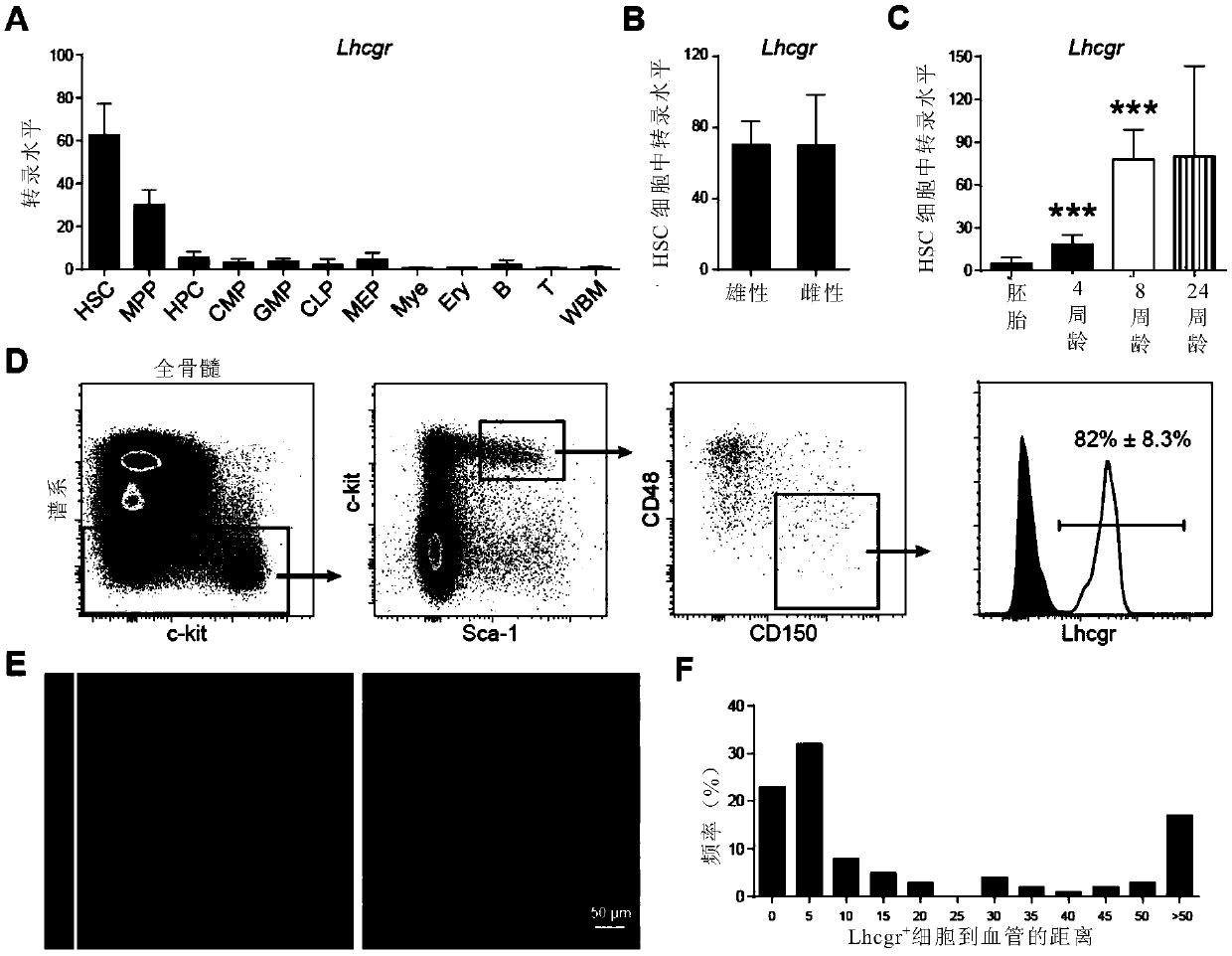Application of luteinizing hormone in inhibition of development of myeloid leukemia
A technology of luteinizing hormone and myeloid leukemia, applied in the field of biomedicine, can solve the problem that tumor cells cannot be completely eliminated
- Summary
- Abstract
- Description
- Claims
- Application Information
AI Technical Summary
Problems solved by technology
Method used
Image
Examples
Embodiment 1
[0123] Example 1: In the blood system, Lhcgr expression is restricted to HSCs and MPPs
[0124] Luteinizing hormone (LH) is associated with the onset of puberty and plays an important role in gonadogenesis in both male and female mice. Previous studies have found that Lhcgr is mainly expressed in primitive hematopoietic stem cells (HSCs) and multipotent progenitor cells MPPs ( figure 1 , A). In mice of different sexes, there was no heterogeneity in the expression of Lhcgr in HSCs ( figure 1 , B). The expression of Lhcgr presents temporal changes in different developmental stages of mice. During the fetal liver period, the expression of Lhcgr in the mouse bone marrow is maintained at the background level. After birth, the expression level of Lhcgr in the mouse bone marrow gradually increases until after birth. 8 weeks to reach a stable ( figure 1 , C), these evidences show that hematopoietic stem cells in the bone marrow are direct targets of LH signaling.
[0125] Simulta...
Embodiment 2
[0126] Example 2: Under steady state conditions, Lhcgr knockout promotes HSC self-renewal and hematopoiesis in mouse bone marrow
[0127] The present inventor constructed Lhcgr gene knockout mice and detected and analyzed hematopoietic-related phenotypes after adulthood, and found that at 8 weeks of age, Lhcgr - / - In the mice, the total number of cells in the bone marrow and the frequency of HSCs were significantly higher than those of the littermate control mice, and the number of HSCs also increased significantly ( figure 2 , A), the number of downstream MPPs, B cells, and T cells increased significantly compared with the control group ( figure 2 , B-F). Competitive hematopoietic lineage reconstitution experiments revealed that the same amount of Lhcgr - / - Mouse bone marrow hematopoietic cells have stronger hematopoietic lineage remodeling ability ( figure 2 , G). Taken together, these data suggest that LH signaling plays an important regulatory role in HSC self-renew...
Embodiment 3
[0128] Example 3: Lhcgr knockout leads to accelerated expansion of leukemia cells
[0129] In this example, the inventors constructed a mouse model of acute myeloid leukemia driven by the MLL-AF9 proto-oncogene. Lhcgr - / - Mice and control Lhcgr + / + Mouse bone marrow C-kit positive cells were sorted by flow cytometry, infected with MLL-AF9 retrovirus, and then transplanted into irradiated recipient mice by ocular vein injection. Using flow cytometry analysis technology, the proportion of YFP-positive cells in the peripheral blood of recipient mice was detected four weeks after transplantation, and the results showed that YFP in the peripheral blood of recipient mice in the experimental group + Lhcgr - / - The proportion of donor leukemia cells (32.5%) was significantly higher than that of the control group (11.7%) ( image 3 , A-B). This AML mouse model mainly expresses the surface molecular markers Mac-1 and Gr-1 of myeloid cells, while the expression of molecular markers r...
PUM
 Login to View More
Login to View More Abstract
Description
Claims
Application Information
 Login to View More
Login to View More - R&D
- Intellectual Property
- Life Sciences
- Materials
- Tech Scout
- Unparalleled Data Quality
- Higher Quality Content
- 60% Fewer Hallucinations
Browse by: Latest US Patents, China's latest patents, Technical Efficacy Thesaurus, Application Domain, Technology Topic, Popular Technical Reports.
© 2025 PatSnap. All rights reserved.Legal|Privacy policy|Modern Slavery Act Transparency Statement|Sitemap|About US| Contact US: help@patsnap.com



